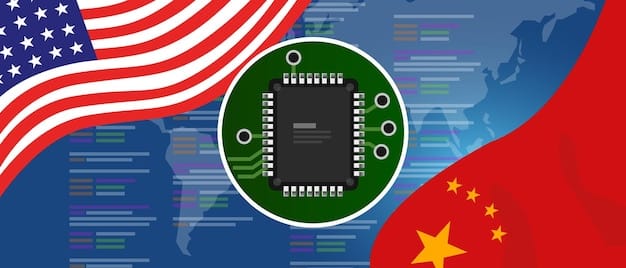Navigating the Future: US Geopolitical Strategies in the Coming Years

How Will the US Navigate the Complex Geopolitical Landscape in the Coming Years? The US will likely employ a multifaceted approach including strengthening alliances, focusing on economic competitiveness, addressing domestic vulnerabilities, and adapting to emerging technologies to maintain its influence in an increasingly multipolar world.
The world stage is constantly shifting, and understanding how will the US navigate the complex geopolitical landscape in the coming years is crucial for anticipating future global dynamics. From emerging technologies to shifting alliances, the US faces a multitude of interconnected challenges.
The Evolving Geopolitical Order
The existing world order, largely shaped by the US after World War II, is undergoing a significant transformation. Understanding the forces driving this change is essential for grasping how the US will adapt its strategies.
The rise of new economic and military powers, coupled with the resurgence of older ones, is creating a more multipolar world. This means the US no longer enjoys the same level of dominance it once did.
The Rise of China and Other Global Powers
China’s economic growth and military expansion have positioned it as a major challenger to US influence. Other nations, like Russia, India, and the European Union, are also asserting themselves more prominently on the world stage.
These shifts in power dynamics require the US to reassess its alliances, trade relationships, and military posture to maintain its strategic advantage.
- Economic Competition: The US must compete with China and other nations in areas like trade, technology, and investment.
- Military Modernization: Maintaining a strong military is still important, but the US must also focus on emerging technologies like cyber warfare and artificial intelligence.
- Diplomatic Engagement: Building strong relationships with allies and engaging in diplomacy are key to navigating a multipolar world.

The US must find ways to cooperate with these rising powers on issues like climate change, global health, and nuclear proliferation, even as it competes with them in other areas.
In conclusion, the evolving geopolitical order presents both challenges and opportunities for the US. Adapting to this new reality requires a comprehensive strategy that encompasses economic competitiveness, military strength, and diplomatic engagement.
Economic Competitiveness and Innovation
Maintaining economic competitiveness is crucial for the US to project power and influence abroad. Investing in innovation, education, and infrastructure is vital for long-term prosperity.
A strong domestic economy allows the US to invest in its military, fund foreign aid programs, and exert economic leverage in international negotiations.
Investing in Key Industries
The US needs to prioritize investments in industries that are critical to its future economic success, such as technology, manufacturing, and renewable energy. This will ensure the country remains at the forefront of innovation.
This includes supporting research and development, providing incentives for companies to invest in the US, and training workers for the jobs of the future.
- Education Reform: Improving the quality of education at all levels is essential for producing a skilled workforce.
- Infrastructure Development: Investing in roads, bridges, airports, and other infrastructure projects will boost economic growth.
- Trade Agreements: Negotiating trade agreements that benefit US businesses will increase exports and create jobs.
The US should also focus on reducing its national debt and improving its fiscal health. This will give the country more flexibility to respond to economic challenges and invest in its future.
In summary, economic competitiveness is a cornerstone of US foreign policy. By investing in innovation, education, and infrastructure, the US can maintain its economic strength and global influence.

Strengthening Alliances and Partnerships
Alliances and partnerships are vital for the US to address global challenges and maintain its influence. Working with like-minded countries allows the US to share the burden of leadership and amplify its power.
Strong alliances provide the US with access to military bases, intelligence sharing, and diplomatic support.
Reassessing Traditional Alliances
The US needs to reaffirm its commitment to traditional alliances like NATO and its relationships with Japan, South Korea, and Australia. These alliances have been the bedrock of US foreign policy for decades.
This includes increasing defense spending, participating in joint military exercises, and coordinating diplomatic strategies.
- Expanding Partnerships: The US should also explore new partnerships with countries in regions like Southeast Asia, Africa, and Latin America.
- Multilateral Institutions: The US should work through multilateral institutions like the United Nations and the World Trade Organization to address global challenges.
- Shared Values: Building alliances based on shared values like democracy, human rights, and the rule of law will create stronger and more resilient partnerships.
The US should also be willing to adapt its alliances to meet new challenges, such as cyber warfare, climate change, and pandemics. This requires flexibility and a willingness to compromise. In conclusion, strong alliances and partnerships are essential for the US to navigate the complex geopolitical landscape. By working with like-minded countries, the US can share the burden of leadership and maintain its influence in the world.
Addressing Domestic Vulnerabilities
Internal challenges, such as political polarization, economic inequality, and infrastructure deficits, can weaken the US and undermine its ability to project power abroad. Addressing these vulnerabilities is crucial for long-term strength.
A divided nation is less able to act decisively on the world stage. Economic inequality can create social unrest and undermine confidence in the US system.
Bridging the Political Divide
Reducing political polarization requires finding common ground on key issues and promoting civil discourse. This can be achieved through education, media literacy, and encouraging politicians to work together.
This includes reforming campaign finance laws, promoting fact-based journalism, and encouraging citizens to engage in respectful dialogue.
- Economic Inequality: Addressing economic inequality requires policies that promote job growth, increase wages, and expand access to education and healthcare.
- Infrastructure Investment: Investing in infrastructure will create jobs, boost economic growth, and improve the quality of life for Americans.
- Social Cohesion: Strengthening social cohesion requires promoting diversity, tolerance, and inclusivity.
The US should also focus on improving its healthcare system, reducing crime rates, and addressing the opioid crisis. These are all issues that can weaken the nation from within.
In summary, addressing domestic vulnerabilities is essential for the US to maintain its strength and influence in the world. A strong and united nation is better able to face external challenges.
Adapting to Emerging Technologies
Emerging technologies like artificial intelligence, quantum computing, and biotechnology are transforming the world and creating new challenges and opportunities for the US. Staying ahead of the curve in these areas is crucial for maintaining a strategic advantage.
These technologies have the potential to revolutionize industries, create new jobs, and improve the quality of life. They also pose risks, such as cyber warfare, autonomous weapons, and misinformation.
Investing in Research and Development
The US needs to increase its investment in research and development in these emerging technologies. This includes funding government research labs, supporting university research, and incentivizing private sector innovation.
- Cybersecurity: Strengthening cybersecurity is essential for protecting critical infrastructure, intellectual property, and national security.
- Ethical Frameworks: Developing ethical frameworks for the use of these technologies is crucial for ensuring they are used responsibly and for the benefit of humanity.
- International Cooperation: Working with allies to develop common standards and regulations for these technologies will promote cooperation and prevent a race to the bottom.
The US should also focus on training workers for the jobs of the future and ensuring that everyone has access to the skills and knowledge they need to succeed in the digital age.
In conclusion, adapting to emerging technologies is essential for the US to maintain its strategic advantage. By investing in research and development, strengthening cybersecurity, and developing ethical frameworks, the US can harness the power of these technologies for the benefit of all.
Navigating Great Power Competition
The dynamics between major global powers will significantly shape the geopolitical landscape. Understanding these relationships, especially with nations like China and Russia, is vital for the US.
The US must manage its relations with these countries in a way that protects its interests and promotes a stable world order.
Managing the US-China Relationship
The US-China relationship is complex and multifaceted. It encompasses areas of competition, cooperation, and confrontation. The US must find ways to manage these competing interests.
Some strategies involve maintaining a strong military presence in the Indo-Pacific region, working with allies to counter Chinese aggression, and engaging in dialogue on issues like trade and human rights.
- Dealing with Russia: The US relationship with Russia is also fraught with challenges, including Russia’s aggression in Ukraine, its interference in US elections, and its support for authoritarian regimes.
- Diplomatic Engagement: The US must be prepared to engage in diplomacy with both China and Russia, even as it confronts their challenges.
- Strategic Patience: Navigating great power competition requires strategic patience and a long-term perspective.
The US needs to work with its allies to develop a coordinated strategy for dealing with these challenges.
In summary, navigating great power competition is a critical challenge for the US. By understanding the dynamics between major global powers and developing a comprehensive strategy for managing these relationships, the US can protect its interests and promote a stable world order.
| Key Point | Brief Description |
|---|---|
| 🌍 Evolving Order | Rise of new powers requires US to adapt strategies. |
| 💰 Competitiveness | Investing in innovation is crucial for global influence. |
| 🤝 Alliances | Strengthening partnerships shares leadership burden. |
| 🤖 Tech Adaptation | Staying ahead in emerging tech is strategically vital. |
Frequently Asked Questions
▼
The US faces challenges from the rise of China, Russia’s assertiveness, cybersecurity threats, climate change, and domestic political divisions, all impacting its global influence.
▼
Investing in education, infrastructure, and key industries is crucial. Also, fostering innovation, reducing the national debt, and negotiating beneficial trade agreements are important steps.
▼
Alliances are vital for sharing leadership burdens and amplifying power. The US must reaffirm commitments to traditional alliances and explore new partnerships for addressing global challenges.
▼
Domestic issues like political polarization and economic inequality can weaken the US and limit its global influence. Addressing these issues strengthens the nation’s ability to project power.
▼
Emerging technologies like AI and quantum computing are reshaping the world. The US must invest in R&D, cybersecurity, and ethical frameworks to maintain a strategic technological advantage.
Conclusion
Navigating the complex geopolitical landscape requires a multifaceted approach from the US, focusing on economic competitiveness, strengthened alliances, addressing domestic challenges, and adapting to emerging technologies. By proactively addressing these key areas, the US can maintain its global influence and safeguard its interests in an evolving world order.





